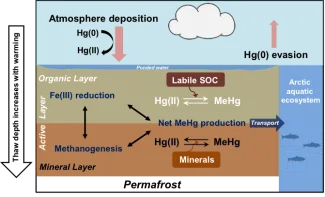Warming increases methylmercury production in Arctic soils
Rapid temperature rise in Arctic permafrost impacts not only the degradation of stored soil organic carbon (SOC) and climate feedback, but also the production and bioaccumulation of methylmercury (MeHg) toxin that can endanger humans, as well as wildlife in terrestrial and aquatic ecosystems. Currently little is known concerning the effects of rapid permafrost thaw on microbial methylation and how SOC degradation is coupled to MeHg biosynthesis. Here we describe the effects of warming on MeHg production in an Arctic soil during an 8-month anoxic incubation experiment. Net MeHg production increased >10 fold in both organic- and mineral-rich soil layers at warmer (8 °C) than colder (–2 °C) temperatures. The type and availability of labile SOC, such as reducing sugars and ethanol, were particularly important in fueling the rapid initial biosynthesis of MeHg. Freshly amended mercury was more readily methylated than preexisting mercury in the soil. Additionally, positive correlations between mercury methylation and methane and ferrous ion production indicate linkages between SOC degradation and MeHg production. These results show that climate warming and permafrost thaw could potentially enhance MeHg production by an order of magnitude, impacting Arctic terrestrial and aquatic ecosystems by increased exposure to mercury through bioaccumulation and biomagnification in the food web.
Climate warming not only influences the degradation of stored soil organic carbon and climate feedback but also the production and bioaccumulation of methylmercury toxin in natural ecosystems. We determined the effects of warming on methylmercury production in an Arctic soil during an 8-month anoxic incubation experiment and found that net methylmercury production increased >10 fold in a permafrost active layer soil at warmer (8°C) than colder (–2°C) temperatures. More importantly, we found that the biosynthesis of methylmercury is strongly coupled with processes such as methanogenesis and iron reduction during soil organic carbon degradation.
Our results show that climate warming and permafrost thaw could potentially enhance methylmercury toxin production by an order of magnitude, impacting Arctic terrestrial and aquatic ecosystems by increased exposure to mercury through bioaccumulation and biomagnification in the food web.
Yang Z, W Fang, X Lu, G-P Sheng, DE Graham, L Liang, SD Wullschleger, and B Gu. 2016. Warming increases methylmercury production in an Arctic soil. Environmental Pollution 214: 504-509. https://doi.org/10.1016/j.envpol.2016.04.069
This research was funded by the Office of Biological and Environmental Research within the U.S. Department of Energy’s Office of Science, as part of the NGEE Arctic and Mercury Science Focus Area project at Oak Ridge National Laboratory.
For more information, please contact:
Baohua Gu
gub1@ornl.gov

